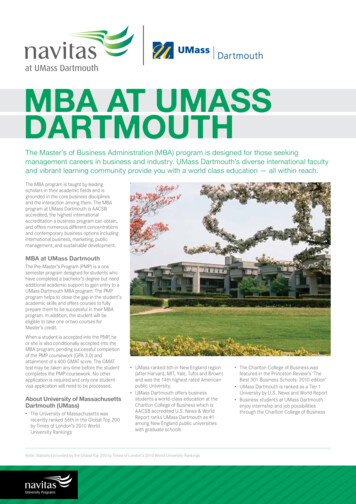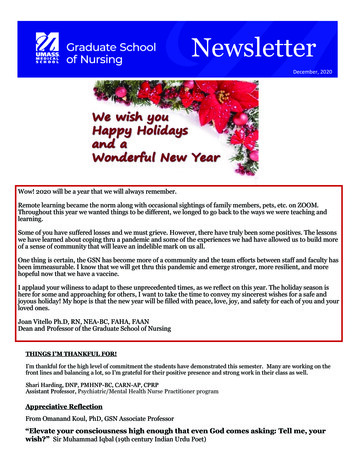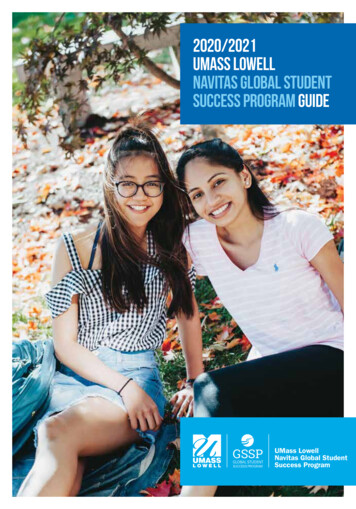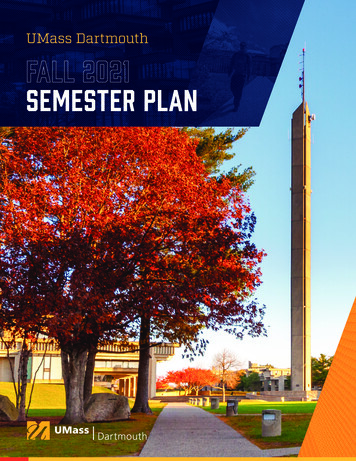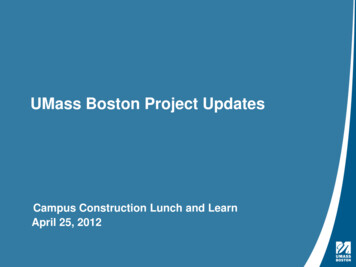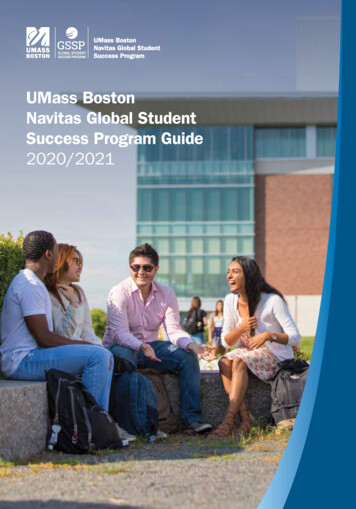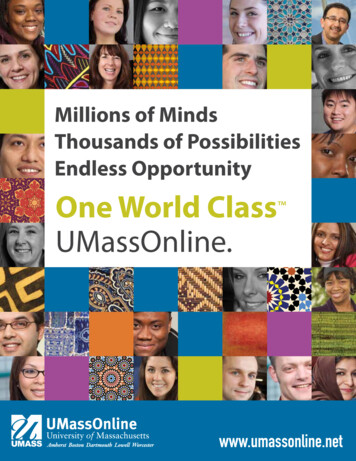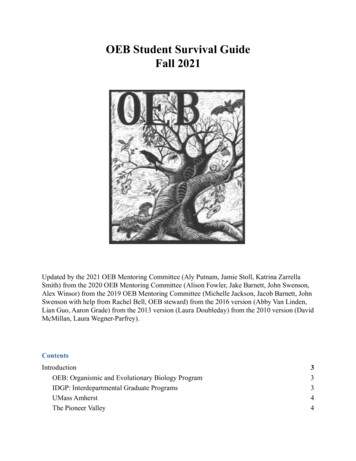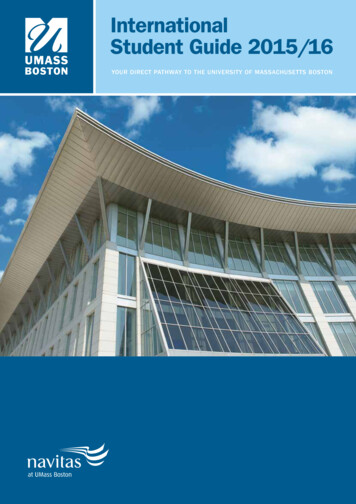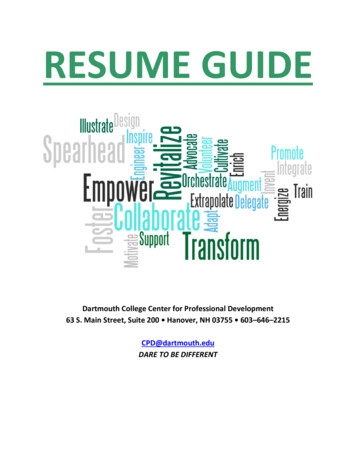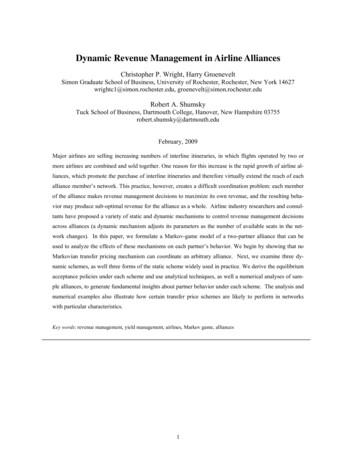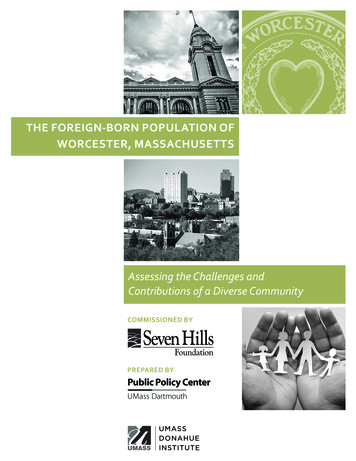
Transcription
Public Policy CenterUMass Dartmouth
ACKNOWLEDGEMENTSThere is perhaps no topic more polarizing in America today than that of immigration and the perceptionof foreign born populations who reside in the towns and cities across our nation. For some, immigrantsare considered the DNA upon which our nation was built and became, over time, the great melting pot.For others, foreign born populations are demonized as illegals who take American jobs, clog up ouremergency rooms and schools, and negatively impact our national criminal justice system.Having such extreme viewpoints about an issue as important as immigration clouds our ability to developsound policy and workable strategies that support families and communities. With this in mind, the SevenHills Foundation chose to take a more dispassionate and scholarly look at both the challenges andcontributions of the diverse community here in Worcester, Massachusetts. This report, commissioned bySeven Hills Foundation and authored by the Public Policy Center at UMass Dartmouth and the UMassDonahue Institute, is a summary of the research conducted over a 7 month period beginning in January,2015. It is our hope that the findings may contribute to a more balanced perspective of what individualsborn outside of America bring to this Central Massachusetts community. Additionally, it is our earnesthope that this report will contribute to the community dialogue on immigration broadly and instigateenlightened local public policy.The genesis of this report began with a discussion I had with Mayor Joseph M. Petty and City ManagerEdward Augustus, Jr following the 2014 national debate concerning the potential relocation of foreignborn children to Massachusetts from federal holding facilities in Texas and elsewhere. The vitriolicrhetoric which was expressed by some Massachusetts elected officials was stunning in its hyperbole,which in turn led both the City Manager and Mayor of Worcester to express the need for a more soberunderstanding of the dynamics surrounding Worcester's foreign born populations. I want to thank bothMayor Petty and City Manager Augustus for their earnest interest in supporting all citizens of Worcesterand for their interest and support in producing this report.The work contained herein could not have been possible without the generous financial support of theTrustees of the George F. & Sybil H. Fuller Foundation; the Trustees of the Stoddard Charitable Trust; andthe Trustees of the Fletcher Foundation. Their individual and collective concern and dedication to thecitizens of Worcester and Central Massachusetts is without comparison.It is my sincere desire that public officials, students, advocacy and service organizations, the generalpublic, and others interested in better understanding the dynamics surrounding our foreign-bornpopulations in Worcester may use this document as a source of information and reflection.Dr. David A. JordanPresident, Seven Hills Foundation & AffiliatesJuly 2015
ABOUT THE PUBLIC POLICY CENTER AT UMASS DARTMOUTHThe Public Policy Center (PPC) at UMass Dartmouth is the University’s applied social science research,technical assistance, and public service unit based in the College of Arts and Sciences. An interdisciplinaryapplied public policy research and technical assistance provider, the Center seeks to inform evidencebased policymaking at the state, regional, and local level through collaborative engagements with public,private, and non-profit partners.The Center is supported by a highly experienced team of professionals who leverage the skills andexpertise of UMass faculty, staff, and students to meet the needs of our clients and partners. Servicesprovided by the PPC include survey research, program evaluation (summative and formative), economicand workforce analysis, demographic and socioeconomic analysis, technical assistance, and needsassessment. These services are offered in the areas of economic development, community development,education, public health, transportation, housing, and environment.ABOUT THE UMASS DONAHUE INSTITUTEUMass Donahue Institute delivers client-focused solutions in the areas of applied research, programevaluation, organizational development, management support, educational programming, internationalexchange programming, training & technical assistance and workforce development services.This is accomplished by bringing the intellectual resources of our staff and the University ofMassachusetts system, along with the abilities of a broad range of consultants and organizations, to bearon the needs of its clients. The Institute serves clients in the public, non-profit, and private sectors locatedhere in the Commonwealth and throughout the nation and the world.ABOUT THE SEVEN HILLS FOUNDATIONSeven Hills Foundation is a network of affiliated organizations providing comprehensive, integratedhealthcare and human service supports for people with significant life challenges. The basic principal ofserving others is the cornerstone upon which Seven Hills has built its Mission and Vision for over 60years. With over 190 locations in Massachusetts, Rhode Island and eight countries abroad, Seven HillsFoundation is the premier provider of clinical and related supports for over 25,000 individuals.
REPORT AUTHORSDr. Michael D. Goodman, Executive DirectorDavid R. Borges, Director of Research and AdministrationMichael P. McCarthy, Graduate Research AssistantJason D. Wright, Graduate Research AssistantTrevor V. Mattos, Graduate Research AssistantJawanza Foster, Research AssistantChristina Citino, Senior Research ManagerMolly Fenton, Senior Research AnalystThe findings in this report are based on analysis by the Public Policy Center at UMass Dartmouth and theUMass Donahue Institute. Data was sourced from the U.S. Census Bureau’s 5-year 2009-2013 AmericanCommunity Survey (ACS) and Public Use Microdata Samples (PUMS). In order to provide context for thisdata, the UMass Donahue Institute conducted a qualitative study through interviews with serviceproviders and immigrant advocates in Worcester.
ContentsExecutive Summary . i1.0Overview. 12.0Purpose of the Report. 63.0What Is the Size and Origin of Worcester’s Foreign-Born Population? . 84.0What Are the Demographic Characteristics of Worcester’s Foreign Born?. 165.0What is the Economic Profile of Worcester’s Foreign Born?. 256.0How are Worcester’s Major Foreign-Born Groups Unique? . 307.0Are Worcester’s Foreign Born Primarily Employed In Entry-Level, Low-Paying Jobs?. 388.0Do Worcester’s Foreign Born Utilize Public Benefits At a Higher Level Than Natives? . 449.0Are Worcester’s Foreign Born More Likely to Be Uninsured? . 4810.0 What is the Economic Impact of Consumer Spending By Worcester’s Foreign Born? . 5011.0 What Are the Impacts of Foreign-Born Children on the Worcester Public Schools? . 5412.0 Conclusion. 59Appendix A: Countries and Regions of Origin for Comparative Analysis. 62
The Foreign-Born Population of Worcester, Massachusetts:Assessing the Challenges and Contributions of a Diverse CommunityEXECUTIVE SUMMARYThe City of Worcester, Massachusetts has long been a center for innovation, industry,and education. Since its incorporation in 1848, these features have made the city adestination for immigrants from a variety of national, cultural, and socioeconomicbackgrounds. As with most New England mill towns, Worcester’s immigration historybegins with successive waves of Europeans. In the mid-twentieth century, Worcesterbegan receiving a large number of Latin American immigrants, peaking in the 1970s.Worcester has seen a surge in African and Asian immigrants since the 1990s, thoughAsian immigration has outpaced African arrivals since 2010. Most African immigrantsemigrate from Ghana and Kenya, and Asian immigrants from Vietnam, China, and India.Currently, Worcester has more for eign-born residents than any other MassachusettsGateway City.This report provides a profile of the foreign-born population in Worcester that highlightstheir unique challenges and contributions. The analysis also focuses on the impact thechildren of the foreign-born have on the public education system, and provides adetailed comparison of Worcester’s largest foreign-born subpopulations. Qualitativeinterviews with immigration service providers detail the challenges of supportingcommunities of refugees and other immigrants endeavoring to make a life forthemselves and their families in Worcester. Worcester’s Foreign-born Population: Size and Country of OriginThe continual flow of immigrants into Worcester from different parts of the world lendsa level of diversity in the foreign-born population that makes Worcester unique whencompared with the state or other Gateway Cities. Worcester is home to an estimated 37,970 immigrants from 85 countries, whichmake up 21 percent of the city’s total population. This compares to 15 percentstatewide. The majority of Worcester’s current foreign-born residents entered the country after1990. The largest concentrations of foreign-born residents hail from Ghana (10 percent ofall foreign born), the Dominican Republic (10 percent), Vietnam (9 percent), Brazil (6percent), and Albania (5 percent). Over half (51 percent) of Worcester’s foreign born are not US citizens while 49percent are naturalized US citizens. Most naturalized citizens gained citizenshipbetween 2000 and 2010. Among noncitizens in Worcester, ther e are an estimated 5,500 unauthorizedimmigrants.i
The Foreign-Born Population of Worcester, Massachusetts:Assessing the Challenges and Contributions of a Diverse Community The Department of State r eported 2,196 refugee arrivals in Worcester between 2007and 2012. An estimated 70 percent of all Asians and 46 percent of all Africans in Worcester areforeign-born. Comparatively, 24 percent of all Hispanics, and 12 percent of all whiteresidents are foreign-born. Demographic and Socioeconomic Characteristics of the Foreign bornMany of the foreign born, especially noncitizens, are of prime working age (25-44 yearsold) and actively participate in the workforce. Economically, naturalized immigrants as agroup fare better than both natives and noncitizens, while noncitizens are more likely tobe economically disadvantaged than natives or naturalized immigrants. Worcester’s foreign born are almost two times more likely than natives to be ages 25to 44, with this age cohort accounting for 42 percent of immigrants. This comparesto 24 percent of natives. Naturalized foreign-born residents have the highest median household income( 50,865) of all groups– measured against native households ( 46,263) andnoncitizen households ( 37,944) Overall, the foreign born, particularly naturalized citizens are slightly less likely thannatives to live in poverty. Naturalized foreign-born residents have the highest rates of home ownership (53percent) in Worcester as compared to natives (46 percent) and noncitizens (19percent). Approximately half of all foreign-born persons spend 30 percent or more of theirincome on housing costs, compared to one-third of all natives. Despite having the highest average number of workers per household, noncitizenhouseholds earn considerably less than native and other foreign-born households,and are most likely to live in poverty. More than half of immigrants in Worcester have low English proficiency. Englishproficiency correlates with earnings – on average, those with high proficiency earn 15,000 more per year than those with low proficiency. Analysis of public benefit usage rates reveals that the foreign born access publicbenefits at rates equal to or below those of the native born. Health insurance enrollment is high for all groups; 96 percent of natives and 91percent of foreign-born residents have health insurance. Use of publicly supportedhealth insurance (Medicaid/MassHealth) is slightly higher for native residents.Noncitizens have the highest concentration of uninsured individuals.ii
The Foreign-Born Population of Worcester, Massachusetts:Assessing the Challenges and Contributions of a Diverse Community Comparative Analysis of Major Foreign-born SubpopulationsMany new immigrants face similar challenges, such as securing access to healthcare,finding affordable housing, and entering the workforce or education systems. However,a comparative analysis of Worcester’s major foreign-born subpopulations revealed thatregional groups differ significantly with respect to various social and economicindicators. Labor force participation is extremely high among foreign-born African (88 percent)and Latin American (77 percent) groups, compared with Asians (65 percent),Europeans (61 percent) and Worcester overall (64 percent). Educational attainment is higher for foreign-born residents of European origin (44percent) than for Worcester overall (38 percent) and lower for residents of LatinAmerican origin (21 percent). English proficiency is higher among foreign-born residents from Africa (89 percent)and Europe (81 percent) than for Asian (63 percent) and Latin American (61 percent)immigrants; citywide proficiency is 79 percent Medicaid/MassHealth enrollment is lower for foreign born Africans (26 percent) andEuropeans (21 percent) than for Asians (37 percent) and Latin Americans (50percent); citywide enrollment is 34 percent Median annual individual income is highest for Africans ( 28,222) and lowest forLatin Americans ( 20,454), whereas the citywide annual median is 23,202. Poverty rates are lower among the for eign born than citywide, except for LatinAmericans (23 percent) who match the citywide poverty rate and have a slightmajority (53 percent) at or below 200 percent of poverty. Economic Impact of the Foreign BornWorcester’s foreign born contribute to the economy in various ways, with significantimpacts resulting from their role as producers (i.e. workers and business owners) and asconsumers of local goods and services. Foreign-born business owners and consumersmake disproportionately large contributions to the local economy. Foreign-born entrepreneurs account for 37 percent of all business owners inWorcester, double the statewide rate. Historically, immigrant entrepreneurs aremore likely to own neighborhood-based businesses such as restaurants, groceries,and retail stores. Foreign-born adults are more likely than natives to have earned a degree in science,technology, engineering, mathematics, or healthcare fields.iii
The Foreign-Born Population of Worcester, Massachusetts:Assessing the Challenges and Contributions of a Diverse Community Employers in the Worcester Metro area make over 1,000 visa requests annually forforeign-born workers (through the H1B visa program), representing 9.5 percent of allNew England requests outside of metropolitan Boston. Foreign-born workers collectively earn 947 million annually, which represents 26percent of the nearly 3.7 billion in total earnings citywide. Worcester’s foreign born spent an estimated 472 million in the local economy in2015. These consumer expenditures resulted in an estimated 715 million in localeconomic output (sales), 256 million in new labor income, all of which supported anestimated 5,695 jobs in the Greater Worcester economy (defined as Worcesterproper and contiguous communities). English Language Learner (ELL) EducationThe size of the ELL student population in Worcester has increased dramatically in recentyears. The vast majority English language learners in Worcester were born in the US andhave varying levels of English proficiency. Worcester Public Schools offers a variety ofELL programs in order to address the unique challenges of this student population. ELL students in Worcester Public Schools increased from 13.5 percent to 35.1percent of all Worcester public school students between 2004 and 2015. Statewide,the ELL student population grew from 5.0 percent to 8.5 percent of all studentsduring the same period. In FY16, ELL students will cost the Worcester Public Schools an average of 9,303 perpupil as compared to non–ELL students which are expected to cost between 6,942and 8,657 per student. Overall, one third of all children in Worcester have at least one foreign-born parent.Most children of the foreign born are U.S.–born, and 17 percent of Worcester’schildren have at least one parent who was born outside of the U.S. The vast majority (95 percent) of English Language Learners wer e born in the U.S.;Ghana is the second most common country of origin, but it accounts for only 1.8percent of all ELL students. Of the 85 different languages spoken by ELL students in Worcester, Spanish is themost common followed by Vietnamese. Other major languages include Albanian,Twi, Arabic, Portuguese, Patios, and Nepali. Worcester has an ELL student-to-teacher ratio of 62:1, compared with the statewideratio of 40:1.iv
The Foreign-Born Population of Worcester, Massachusetts:Assessing the Challenges and Contributions of a Diverse Community1.0OVERVIEWImmigration in modern America is one of today’s most widely deliberated topics. Publicdebates rage on about immigration policy and how to address issues related to thepresence of undocumented immigrants in the United States. Central to — though oftenmissing from — the discussion of immigration is a fact-based understanding of theoverall “immigrant population,” including the size and cultural identities of thepopulation, their socioeconomic and other demographic characteristics, access to andutilization of publicly provided services and benefits, and the role they play in thecultural and economic life of cities and towns.Like many cities and towns across America, Worcester is grappling with the widespreadand complex impact of its sizable immigrant population. In order to support a rationaland productive discussion about this critical topic, key stakeholders throughoutWorcester recognized the need for objective, quantitative information to support publicdiscourse and policy development. This research report is designed to bring facts to bearon a number of relevant and important issues in an effort to assist Worcester's leadersin addressing community concerns and developing evidence-based policies goingforward.WORCESTER: A CITY OF IMMIGRANTSWorcester, Massachusetts is situated at the crossroads of New England, locatedapproximately 45 miles from Boston, 40 miles from Providence, and 60 miles fromHartford. Worcester’s current population of 182,544 makes it the second largest city inNew England behind Boston (645,966) and larger than the populations of Providence(177,994), Springfield (153,703), and Bridgeport (147,216). 1Worcester is comprised of over forty distinct neighborhoods, which are home toresidents from nearly all corners of the globe who contribute to a culturally rich anddiverse environment through distinct languages, customs, and traditions. Adding to thisenvironment are Worcester’s nine colleges and universities that enroll over 33,000students, including an estimated 2,700 international students.Like many of the Commonwealth’s “Gateway Cities,” Worcester was once a prominentindustrial center that attracted immigrants from around the globe. The city’s centrallocation made it a major hub in the mid-1800s for stagecoach and railroad companies,and the opening of the Blackstone Canal in 1826 brought increased opportunities formanufacturing, trade, and commerce along with a population boom. Between 1828 and1850, the city’s population more than quadrupled, with much of this growth fueled byIrish, French, and Polish immigrants. 2 Swedish immigrants also arrived in great numbers12U.S. Cens us Population Estimates Program, July 1, 2013.“Worces ter in the 19th Century: Immigration.” Worcester Historical Museum, 2009.1
The Foreign-Born Population of Worcester, Massachusetts:Assessing the Challenges and Contributions of a Diverse Communityduring this period, making it one of the major destinations for Swedes on the EastCoast. 3A wave of Turkish, Armenian, and Syrian immigration followed in the late 1800s. At thebeginning of the 20th c entury, Worcester became home to increasing numbers ofimmigrants from southern and western Europe and the Middle East. By the time of the1920 Census, 70 percent of Worcester’s population had been born abroad or had atleast one head of household who was foreign born. 4Recent shifts in country of origin among Worcester’s immigrants include a sharpincrease in Latin American and Asian populations beginning in the 1970s and morerecently from Africa (primarily from Ghana and Kenya). Currently, the city’s populationincludes an estimated 37,970 foreign-born residents primarily from Ghana, Vietnam, theDominican Republic, Brazil, Albania, El Salvador, China, Kenya, India, Poland, andColombia.WHAT DOES IT MEAN TO BE FOREIGN BORN?Much has been written about the American immigrant experience. The term aloneevokes images of the huddled masses coming to the shores of the United States insearch of new opportunities. However, today’s immigrant experience is very differentfrom the days when massive waves of immigrants settled the country. In fact, thegeneric label immigrant no longer fully describes the various groups of foreign-bornindividuals residing in the culturally diverse communities of Worcester.Although often used interchangeably, the term “immigrant” does not accuratelydescribe all of the nearly 38,000 foreign-born residents living in Worcester today.Foreign-born persons include anyone who was not a United States citizen at birth,including those who have become naturalized American citizens. Persons born abroadof American parents or those born in the U.S. territories of Puerto Rico, Guam, or theU.S. Virgin Islands are not considered foreign born, as they are eligible for U.S.citizenship through birthright. By contrast, the native-born population includes thosewith birthright citizenship, meaning their acquisition of United States citizenship was byvirtue of the circumstances of birth. Although children born in the U.S. to foreign-bornparents are native-born citizens, it is important to consider their common preservationor partial preservation of foreign-born cultural customs and languages. In this sense, thenative-born children of the foreign-born parents are in many ways part of and/orconnected to the foreign-born community and any associated challenges andopportunities.“Swedish Immigration to North America.” Augusta College: Swenson Swedish ImmigrationRes earch Center, 2015.4 “Worces ter in the 19th Century”32
The Foreign-Born Population of Worcester, Massachusetts:Assessing the Challenges and Contributions of a Diverse CommunityThe foreign-born population in Worcester includes a variety of individuals with differentforms of legal, residency, and employment statuses. Persons typically conceived of asimmigrants—those who emigrate from their home country to establish a new life, oftenin pursuit of greater social and economic freedom and opportunity—represent onesubgroup within this foreign-born population. Legally admitted immigrants with “greencards” are considered permanent resident aliens; they are able to permanently live andwork in the United States, and they may become naturalized citizens after a period oftime if they so choose.An additional important subgroup within Worcester’s foreign-born population are thosewho have refugee or asylee status. Under U.S. law, a refugee is “someone who has fledhis or her country of origin because of past persecution or a fear of future persecutionbased upon race, religion, nationality, political opinion, or membership in a particularsocial group. If the person is not in the U.S., he or she may apply for inclusion in therefugee program. If the person is already in the U.S., he or she may apply for the U.S.asylum program.” 5In many ways, refugees are similar to the broader immigrant population living inWorcester. However, there is one important difference: By virtue of being refugees,these for eign-born individuals receive direct resettlement services and financialassistance not available to the larger immigrant population. Through the Department ofState’s Reception and Placement program, resettlement agencies receive a one-timepayment per refugee to assist with the expenses associated with the refugee’s first fewmonths in the United States. Funds are used for r efugees’ rent, furnishings, food, andclothing, as well as to pay the costs of agency staff salaries, office space, and otherresettlement-related expenses that are not donated or provided by volunteers.Refugees receive authorization to work in the U.S. upon arrival. After one year in theUnited States, refugees are required to apply for permanent residence, and after fiveyears, they are eligible to apply for citizenship.In addition to immigrants and refugees, the foreign-born population in Worcester alsoincludes individuals who are in the country on a temporary basis, primarily foreducational or employment related reasons. Regardless of whether a foreign-bornindividual enters the United States as an immigrant, refugee, foreign worker, orinternational student, they must adhere to the processes instituted by the U.S.Department of Homeland Security. In those cases where a foreign-born individual doesnot adhere to the r equired processes for entering the United States, they areconsidered undocumented and out of compliance with federal immigration laws. Insome cases, an individual may enter the U.S. legally with a temporary visa, but becomean undocumented individual if he or she does not leave when the visa s-asylum/refugees/questions-answers-refugees.3
The Foreign-Born Population of Worcester, Massachusetts:Assessing the Challenges and Contributions of a Diverse CommunityWorcester’s foreign born come from all corners of the world, and include white, Englishspeaking groups, as well as African, Asian, Middle Eastern, and Latin American groups.As such, communities of foreign-born residents are extraordinarily diverse and do notalways neatly conform to social or political designations. Furthermore, Worcester’s richcultural diversity cannot solely be attributed to the for eign-born population residing inthe city. In fact, Worcester has a sizable Puerto Rican population, including manyindividuals who speak Spanish and may be perceived by some to be part of the city’sforeign-born population. However, as noted above, Puerto Ricans are U.S. citizens bybirthright and are not foreign-born.WORCESTER: A WELCOMING CITYFor well over a century Worcester has been home to organizations with a mission tosupport foreign-born residents including support societies that were founded to aidimmigrants in establishing a foothold in Worcester. The Mission Chapel, the oldest ofWorcester’s immigrant-focused charitable groups, was founded in the 1850s to improvethe lives of Worcester’s poor and immigrant factory workers through religion,education, and social support.During the following decade, civic and business leaders founded Worcester PolytechnicInstitute as a place to train skilled laborers and develop new industrial technology. TheInstitute’s founding is an example of Worcester’s long history as a center not only formanufacturing but also for innovation and creativity. Thus, while many of NewEngland’s older industrial communities have struggled with the structural shocksassociated with deindustrialization, Worcester to a great extent transitioned moresmoothly into a post-industrial economy that is now anchored by advancedmanufacturing, biotechnology, information technology, and healthcare. As the researchfindings discussed in the pages to follow document, immigrants continue to play animportant role in maintaining an innovative and competitive workforce supporting ofthese industries.Presently, agencies and coalitions continue to welcome and support newly arrivingforeign-born residents. Ascentria Care Alliance, formerly Lutheran Social Services ofNew England, is a Worcester-based multi-service agency founded in 1872 with a robustprogram called Services for New Americans. Catholic Charities of Worcester County alsooffers extensive refugee, citizenship, and immigration services. Notably, Ascentria andCatholic Charities are designated refugee resettlement agencies and work with the U.S.State Department and the Massachusetts Office of Refugees and Immigrants to resettlerefugees in the greater Worcester area. In addition to the two designated refugeeresettlement agencies, Worcester has a variety of organizations that work with thevarious communities of foreign-born individuals residing in Worcester. These agenciesinclude, but ar
The findings in this report are based on analysis by the Public Policy Center at UMass Dartmouth and the UMass Donahue Institute. Data was sourced from the U.S. Census Bureau's 5-year 2009 -2013 American Community Survey (ACS) and Public Use Microdata Samples (PUMS). In order to provide context for this data, the UMass Donahue Institute .
